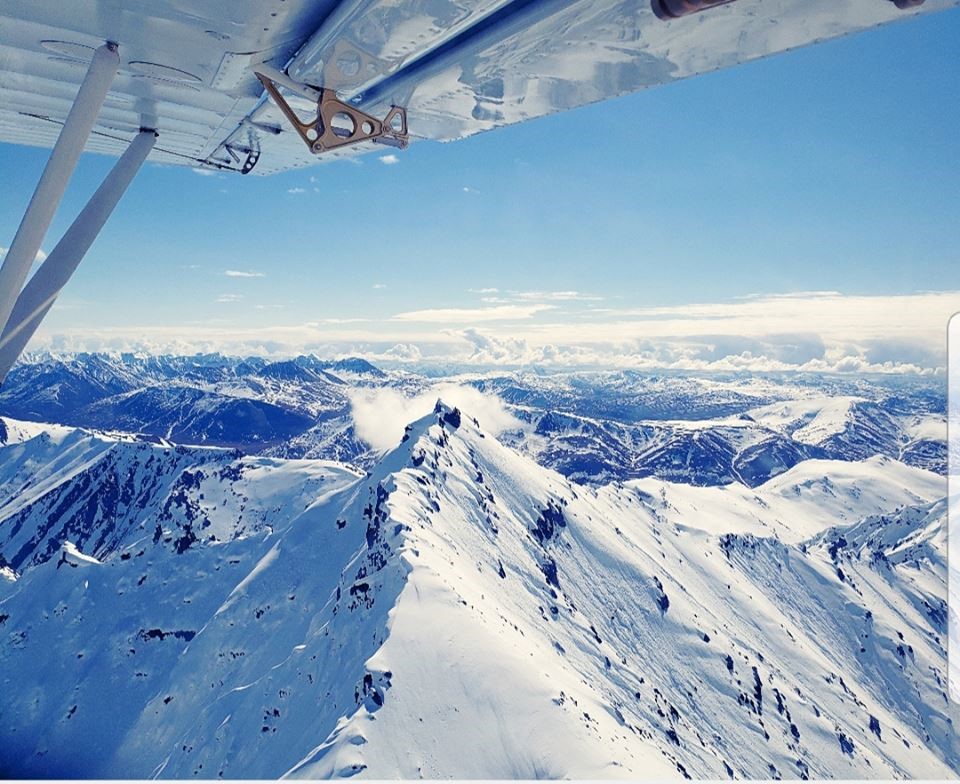
Pilots meet up on Chandler Lake on the final day of surveying. Photo by NPS/Sara Germain.
Why does this project utilize aerial surveys instead of ground-based surveys?
Aerial surveys and ground-based surveys both can measure populations of wildlife, but ground-based surveys have proven to be a difficult method of measurement for the brown bears in Alaska due to its vast and inaccessible wilderness.Twin wildlife biologists Frank and John Craighead were one of the pioneers of researching grizzly bear (a subspecies of brown bear) populations in the United States. In the 1970’s, the biologists measured the Greater Yellowstone Ecosystem grizzly population using a ground-based survey method called “mark-recapture,” the process of live-trapping animals, then distinguishing them with a unique, individualized mark like ear tags or collars. This method is effective in areas where bears congregate at a food source (i.e. Yellowstone National Park’s dump); however, this method fails to work in interior Alaska, where populations of brown bears are larger, more spread out, and do not congregate at food sources. Brown bears in Alaska also have substantial home ranges (50-150mi2), and are known to travel large distances in short times.
The diverse terrain of Alaska is a huge obstacle to ground-based surveys, due to tussocks, wetlands and bogs, rivers, mountains, and rocky outcrops, which make for difficult navigation with ATVs. Bush planes have the ability to circumvent these obstacles and access even the tallest peaks or steepest slopes through expert flight. For some wildlife surveys, up to 6 planes work together to cover large areas of interest. In cooperation with NPS pilots and contractors, wildlife aerial surveys are a cost, time, and labor-efficient alternative to ground-based surveys.

The view from the cockpit of the Supercub in Gates of the Arctic National Park and Preserve. Photo by NPS/Sara Germain.
How do NPS biologists in Alaska conduct aerial surveys for brown bears?
Aerial surveys are used throughout Alaska for various wildlife, including waterfowl, moose, caribou, and bears. The NPS is currently testing the efficacy of a photo-based method to estimate bear populations; a “mark-recapture” method without live-trapping. To find bears using photos, timing is essential. The NPS team of biologists plan the research around when the bears are estimated to emerge from their winter hibernation, and before willows and other plants grow too densely to see bears from the sky. Brown bears stand out better against the ice and snow in spring.Brown bear aerial surveys occur in different parks within the Arctic Network (ARCN) each year. Two aircraft work in tandem to survey a given area, called a “unit.” The teams search for brown bears, taking pictures of individual animals as they find them. Once they are finished surveying, teams compare photos and the exact GPS coordinates at which they found each bear. Once the photos and locations are compared, biologists can use statistics to get a rough idea of how many bears exist in an area. Brown bear populations’ health can help us make informed decisions about the health of an ecosystem as a whole.

A breeding pair of brown bears sit and watch as the plane passes. Photo by NPS/Delaney Vincent.
Where did the survey occur this year?
This year, the team surveyed Gates of the Arctic (GAAR) National Park and Preserve. GAAR is home to a myriad of different habitats ranging from lowland taiga to barren ridges and peaks. Most notably, the Brooks Range maintains a commanding presence within the park, jutting thousands of feet into the sky. Brown bears exist in a density of about 1 bear/100 mi2 here in the park, so pilot/observer teams often went entire days or longer without seeing one bear in their assigned units.
NPS Biological Science Technician, Sara Germain, poses for a photo in front of one of the Supercubs used on the aerial survey. Photo by NPS/Max Newton.
What was it like to conduct an aerial survey for brown bears in the Brooks Mountain Range?
I work as a Biological Science Technician for the National Park Service in Kotzebue, AK. I was given the opportunity to help spot brown bears in GAAR for this year’s aerial bear survey.Though I have worked as an observer for aerial moose surveys with ADF&G and USFWS in the past, spotting brown bears in this Arctic landscape was a new and challenging experience. Fortunately, we had a team of highly talented pilots who were patient with me as I learned the ropes. I quickly caught on to various strategies that were most effective to spotting bears.
At first glance, I did not expect to find any sort of life on the precipitous ridgetops that define the Brooks Mountain Range. I soon realized that Brown bear sows with cubs seek high elevations as refuge from boars, who will hunt young cubs. The family will remain in these elevated areas until the end of mating season, after which they may return to lower areas in search of more nutritious foods.
Not only was I surprised by the wide assortment of habitats bears inhabited in the springtime, I was also impressed with the natural camouflage brown bears have to blend in with their environment. Despite the seemingly endless assortment of blonde, brown, and even black hues and patternings that brown bears possess, it truly takes a well-trained eye to be able to pick them out of shrubs, tundra, or even rocks from a fixed-wing plane. Overall, this survey granted me new respect for bears and a better understanding of their natural behavior and habits.
Written by Sara Germain
Edited by Lauren Utykanski
